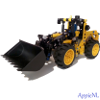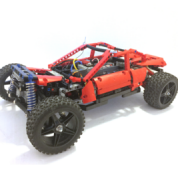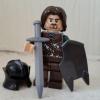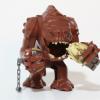Search the Community
Showing results for tags 'Power Functions'.
Found 368 results
-
Somewhere between talking to CommanderWolf about boxcabs, seeing his HH1000, and reading up on old diesel-electric locomotives on the internet, I somehow got the idea to build a model of the very first production diesel-electric locomotives in the United States. These locomotives were produced by a consortium of three companies: ALCo, General Electric, and Ingersoll-Rand. Diminutive as they were (this model represents a 60-ton, 300hp locomotive), they are the direct ancestors of the diesel-electric locomotives powering the US rail system today. As far as I can tell, only three locomotives were actually built with this specific layout: CNJ #1000, B&O #1, and Lehigh Valley 100. Later models featured doors at both ends in addition to the sides; in addition, larger 100-ton versions were built. They could run in either direction, although there are distinct ends and sides: the above image shows the "B" side and "2" end (which I consider the "rear" of the locomotive). I went into construction pretty set on equipping this locomotive with Power Functions while still building an accurate model (at the same scale as the rest of my locomotives). While there are examples of very small Power-Functions-equipped locomotives, I was pretty much dead-set against using the Power Functions train motor -- the locomotive would be too fast, and I wouldn't be able to accurately model the trucks. So, I had to fit motor(s), battery box, and receiver into the shell of the locomotive: As usual, the Power Functions receiver turned out to be the biggest bugbear in this whole adventure. Its shape is extremely inconvenient. While there is just barely enough room to fit Power Functions M motors vertically inside the locomotive above the trucks, placing them would imply that the battery box would have to go between them ... leaving no room for the receiver. I was not going to accept powering only one of the trucks (for a model this light, you need all the traction you can get). The locomotive is not long enough to orient the M motors any other way, so I turned to the trusty 9V gearmotor instead. However, I determined that, even using that motor, there wasn't enough room inside the model for both two motors and the receiver. It was around this point that I decided that 7-wide was the correct width for the model, to avoid it looking too big (it also resulted in better proportions for the windows at the end of the locomotive). At 7-wide, there are only 5 studs of width inside the locomotive, of which 4 studs are taken up by the battery box. The transmission would have to either be 1 stud wide, or I would have to integrate panels into the side of the locomotive in the hopes of hiding the gearing. So what did I do? Restrictions breed creativity: (chain doesn't connect correctly due to LDD difficulties) Turns out, the entire drivetrain can be made to fit into the space available using a chain. The grey idler wheel attaches to a 1x2 brick with pin in the wall of the locomotive. Other parts of the drivetrain are similarly integrated with the body, and the motor and battery box form integral parts of the model's frame. The Power Functions receiver just barely fits in this awkward position above the gears on the non-motor end, and receives signals through a trans-black 1x2 brick on the roof: It is actually a pretty decent puller despite its small size (it is the "AGEIR" listed in this thread; the power rating has since risen to ~0.2W after I carefully lubricated and reassembled the entire drive system). Oddly for a PF-equipped locomotive, it is possible to back-drive the motor by pushing the locomotive, due to the low mechanical resistance of the 9V gearmotor. An additional side "benefit" of the drive system is that the chain makes a pleasant diesel-like clicking/rumbling sound when the locomotive is in motion. As troublesome as all these restrictions (that I placed on myself...) were, I really enjoyed figuring out how to fit all the mechanical components into such a small space, while still maintaining an accurate depiction of the prototype. It just goes to show what's possible using Power Functions. Brickshelf gallery here. If you're curious about the history of these locomotives, you can read about them here.
- 14 replies
-
- power functions
- diesel-electric
-
(and 3 more)
Tagged with:
-

Saberwing40k's WIP and Ideas thread.
Saberwing40k posted a topic in LEGO Technic, Mindstorms, Model Team and Scale Modeling
Well, I've got a bunch of ideas and other random things, as I am building more often, so rather than make a dedicated thread for every off the cuff thing or proof of concept I turn out, I'm just going to compile it here. The first item is a proof of concept chassis for a Gottwald crane, which I meant to be an AK-912, but there are many different models that have a similar chassis, including the AMK-1000, and the AK-680. It's a WIP, but I have other projects I want to finish first, so I made this, and am currently working on an LDD file. Once that file is finished, this thing will be taken apart, so I can use the pieces for other projects, and once I am ready to give this my all, I will use the LDD file to rebuild it. Gottwald AK-912 chassis. by Saberwing007, on Flickr The model is meant to be like an official set, like 42043, meaning one motor, and no RC. The chassi has a V-12 engine, like the real thing, and 8 wheel drive, with a single middle differential. I found that given how far apart the axles are, a differential is required between the 2 sets of driven axles. The different angle between the steering axles is achieved by a diagonal beam, which is very effective. There is almost no backlash, and the axles are in sync automatically. Also, due to how it works, the axles are set to the correct angle relative to each other automatically, due to how it is built, without any calculations. Another picture of the front unit: Gottwald AK-912 chassis. by Saberwing007, on Flickr In addition, the chassis can be separated into three parts, like the real thing. Seperate by Saberwing007, on Flickr Although the steering on the front and rear units works well, it's connecting the two that has proven problematic. I blame lack of stiffness in the middle reversing linkage, and using friction pins for every steering connection. But, for now, this is finished. I will get back to it later, I don't know how much later, though. -
Here's a Beach Buggy I made for an upcoming truck trial this weekend. This trial only has a few rules: Use 62.4 wheels, 2 motors for propulsion max and 1 for steering. It's based on Zblj's "Blue" suspension, drive and steering, modified to fit my beach buggy/trial needs. It features 4 wheel drive and steering. Was a little bit of work to work with the bright green from only 1 Le Mans set. Forgot to make a picture with the suspension pressed. Might make it tomorrow (bad lighting now). It looks pretty sweet with it compressed. The rear wheelarches look like they hug the wheels (a stud or so of space left between wheel and wheelarch). The car bottoms out with the suspension fully compressed. Here you can see how much I stole from Zblj. I only changed the type of suspension arms, slightly altered the steering mechanism and placed my motors differently for a lower look. (ignore my Lego tripod in the bottom right) Thank you for your time.
- 19 replies
-
- buggy
- power functions
-
(and 3 more)
Tagged with:
-
After the realtive succesfull black wolf I think its time to make a new, better and cuter Technic animal. I decided to make a silverfox, since I have some 1000+ of antennas with the gray base. Compared to the black wolf, this model will have many improvments starting with total rebuild of joints. Back in 'ol 2011 the ball joints just came out and were rather a novelity. Now I have enough ball joints, and linear actuators to make a mechanical analougous of hips, shoulder and muscles. Total amount of LA's used in this model will be 10 or more, having 6 large and 4 small LAs. The number of ball joints will be 6, four for legs and 2 for head and tail. I already built a mockup both in LDD and real life. Notice that the body is quite compact even though there are 6M motors, 6LA's and some 30 gears in there. So far it may seem like a unrecognisable shape of bits, but if you looks closer you can see where the legs will attach to the body. The whole body is also double articulated in front and rear. And its articulated to the front and rear can swing not only sideways, but also up and down, so the fox will be able to bend spine in all directions.
-

Oshkosh 10x10 PLS
Zerobricks posted a topic in LEGO Technic, Mindstorms, Model Team and Scale Modeling
Here's what I've been working on in the past few weeks... Features: 10x10x8 wheel drive 6L motors for driving 2 Independent dual gear tranmsissions 2 Steerings motors Very long travel torque sensitive double wishbone portal independent suspension on all wheels Working hook arm with a total of 8 pneumatic cylinders Two newly designed autopumps Interrior with 3 seats For more info please check the video: Now all I need is to get the money to build this 3500+ parts monster... Anyone willing do donate? -

[WIP] Amphibious Sherp 4x4
Zerobricks posted a topic in LEGO Technic, Mindstorms, Model Team and Scale Modeling
After skyping with a good friend of mine braker23 he gave me an idea to make A sherp 4x4. Here's the real deal: It took me an hour to make a first protoype in LDD, which you can see here: As you can see everything is built around the boat hull, so that the model can also float like the real thing. And here's the first rough build in the water: I used track elements wrapped around tumbler wheels to get the paddle shape. I will need 4 more track elements since 2 can fit with ease on each wheel: Underside you can see the reinforcments keeping the boat hull secured: So far there are soem problems with 36 tooth gears skipping under high torque which I belive I can fix by using 8L axles with stop instead of current 5,5 ones. If that doesnt help I can always use small turntables. I also need 4 more tracks, but currently I spent all my money on parts for silverfox and oshkosh 10x10, so these will ahve to wait a bit. I very surprised on how well this thing floats, but it cannot support much more weight, so the bodywork will have bo light and basic in order to keep it from sinking. Whats your opinion guys?- 16 replies
-
- Amphibious
- 4x4
-
(and 4 more)
Tagged with:
-

42029 MOD w/Power Functions
DamonMM2000 posted a topic in LEGO Technic, Mindstorms, Model Team and Scale Modeling
42029 Lego Technic Customized Pickup Truck in highly modified form. Features include ultra-firm dual independent suspension. Motorized with Power Functions. -

How to Motorize the LEGO Mars Rover?
sir_launcelot posted a topic in LEGO Technic, Mindstorms, Model Team and Scale Modeling
I am looking for some suggestions. My daughter is building the Mars Rover set (go here for the details: http://www.eurobricks.com/forum/index.php?showtopic=98222) for a presentation at school and I told her I would help make it operate by remote control with one of the power function kits. Problem is that it is a lot more complex than I thought. (I have no experience at the expert LEGO building). I think I can maybe get it moving with a remote, receiver, and simple motor attached to one wheel, but I do not have any idea how to do the steering and don’t know how to move any of the other functions (camera, antenna, robotic arm). see It was not designed to be converted to power functions / motorized. Here is a photo of the underside: I am not sure the easiest / best way to add power for drive and steering. It just has to move a little bit in the classroom, not drive outdoors in all terrain. I posted in another forum and a member suggested that I post here. Any suggestions to help me figure out what I need to do and what to buy to easily make this work would be much appreciated. Thanks much! -

RCBRICKS Lego compatible servo motors, reviewed by Sariel
Saberwing40k posted a topic in LEGO Technic, Mindstorms, Model Team and Scale Modeling
Today, I found a video from our good friend Sariel about a new, Lego compatible motor system called RCBRICKS, from a startup of the same name. These motors look quite unlike PF motors, and seem to be based off of high torque hobby servo motors, and as such are quite capable. Watch the video for more information. (It's in Polish, but the subtitles are just fine, and in English.) Here are the Pros and Cons, as far as I can see: Pro: Lots of power Highly responsive Great range Should be relatively inexpensive. Compatible with any kind of RC gear. Con: Not compatible with Lego PF system in any way. RC receivers and transmitters are expensive. Questionable battery choice. Motors are entirely new shapes, and not readily compatible with the system, meaning that they are not drop in replacements Unproven startup. Receivers and batteries are not Lego compatible. I don't know, they sound okay, but the thing is, what most people have problems with is either the power supply, or receivers of the Lego PF system, and not the motors. While I think it is a valiant attempt to rectify the Lego systems short range, I don't think they are going about it the right way. I am also kind of dubious about the idea of using a USB batter pack for this, as it is not really Lego compatible, and has to be awkwardly rubber banded in place. It would be preferable if there were a way to go from RC standard to LPF standard, as having all new motors might alienate people who just want a drop in PF receiver replacement, like SBrick. What do you guys think? -
Hello, I noticed that the performance of the original 9398 was not very good so I decided to do this mod including 5 motors. IMG_0086 by JJ2Sam, on Flickr I kept the body original and suspension except shock placement and drive and did extend the wheelbase but kept the original width. The suspension has about ~45* of flex and is responsibly soft and responsive to bumps. I used 2 XL motors in the back, 2 L motors in the front and replaced the servo motor with a M-motor for steering and added 1 pair of headlights. IMG_0116 by JJ2Sam, on Flickr IMG_0117 by JJ2Sam, on Flickr The front axle has a kingpin incline making the wheel pivot near the inside of the wheel making it easier to steer and makes it have less stress on the steering motor. You may be wondering about the use of 2 different motors in the dive chain causing problems in speed differences but your worries can be put to rest because a L motor geared 12/20 is almost the same as 1 XL. IMG_0121 by JJ2Sam, on Flickr Thank you for reading-watching! More pictures on my flickr https://www.flickr.c...6592@N04/albums
- 19 replies
-
- sbrick
- power functions
-
(and 2 more)
Tagged with:
-
Hi all. I'm currently working on a new lego room and loft space and wondering what long term project to start I've had thoughts of the wisbeach and Upwell tramway rekindled. I've always planned a loft railway and this seems like a great prototype for a lego model. Reasonable flat... plenty of character and features on a 'small' scale. I've seen numerous lego versions of 'Toby' the tram and mavis but I'd want them powered. Last time I did lego trains was the 9 system. Could you tell/show me how the newer power functions is set up in the smallest possible space please? I'd love to see your small engines and diesel and find out how you squeeze everything in. Am i right in thinking there's 4 parts... the ir reciever and controller, motor and battery box? I will of course show my progress shortly! For those not familiar with the tramway I found this great little website: http://www.lner.info/co/GER/wisbech/wisbech.php
-

Help And Ideas Needed For Completing My Car
NickGratian posted a topic in LEGO Technic, Mindstorms, Model Team and Scale Modeling
I need suggestion with my car. I have images below of what I have so far. A few questions. What springs should I use. Hard or soft? What wheels or tires? And I need ideas on how to complete it. So far my axle has working steering and a driveshaft connected. I don't know what to do next as I am a new technic builder. If any more information or pictures are needed please tell me :) Images: http://imgur.com/a/QbhXw- 2 replies
-
- Suspension
- Wheels
-
(and 7 more)
Tagged with:
-
I whipped together a motorized turbo tank MOC for an upcoming Star Wars weekend event at the LEGOLAND Discovery Centre. It's 25 inches long, 8 inches wide, and 17 inches high. It features Power Functions, 8 wheel steering, suspension, 10 large Unimog tires, reinforced internal Technic frame in case kids or adults there can't read the 'Do Not Touch' signs. My MOC had to be built with parts I had on hand. The Empire Monetary Fund (EMF) is too broke to finance BrickLink orders after Christmas. Motorized Turbo Tank by dr_spock_888, on Flickr As you can see, I added some non-Star Wars bits for kids to spot. Video:
- 3 replies
-
- MOC
- juggernaut
-
(and 2 more)
Tagged with:
-
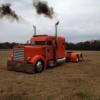
Power Functions Wiring
andrewganschow posted a topic in LEGO Technic, Mindstorms, Model Team and Scale Modeling
I just bought a mini air pump today and an extension wire with the intention of splicing the pump to the wire. I wanted to know which wires on a PF cable carry current, and which carry signal for RC controls. I know there are two wires to carry current and two to carry signal, I’m just not sure which wires do what. Thank you in advance for the help.- 7 replies
-
- Technic
- power functions
-
(and 1 more)
Tagged with:
-

(MOC) ZIL E134 Mad Max/Steam Punk Design-Truck + Instructions
Berghain89 posted a topic in LEGO Technic, Mindstorms, Model Team and Scale Modeling
Hey, i would love to share my latest Creation with you guys. Its been a while since my last MOC, but i took the time to build something cool. It is definitely one of my best so far. And for the first time i decided to provide detailed instruction for this MOC. What are the functions of the ZlL E134 Truck: First of all, i used 2x SBricks and 2x 88000 Battery Packs. 2 XL Motos for propulsion 2 L Motors for steering 1 M Motor for gear change (2 speed transmission) 1 LED on the roof (there is a lot of space to use more LED) a working 12 Zylinder Fake Engine behind the cabin. 2965 Parts , about 3,4 Kg. There is still room for improvements. Under the hood is enough space to put in what ever you want. The whole Bodywork can be removed very easy. (modular design) But as always, a short video can show you the Model in action. Instruction: https://rebrickable....nkmad-max-desig Thanks to Madoka for the inspiration with his Tatra 813 Truck. Great work as always.- 7 replies
-
- MOC
- Steam Punk
-
(and 3 more)
Tagged with:
-
After a month, my Arduino clone has arrived from China. I plan to use it to add some inexpensive automation to our LUG's ad hoc layout. We are starting to display trains and don't have anything permanently built. Some of our events are outside in the park where there is no plug in power. One of the requirements would be battery power option. We are basically starting new with the current LEGO train and power offerings. We agreed to make Power Functions our club standard. I selected an Arduino clone. I figured for $4 USD, it is not a big lost if I fried it. There is a reason it is $4. The clone is not quite exactly the same as the real Arduino UNO. It uses a CH340 USB to serial chip instead of the FTDI USB to serial chip found on the real Arduino. In order for the Arduino IDE to communicate with the board, the CH341 driver has to be installed. It doesn't come with the IDE software from the Arduino website. The driver can be downloaded from the Chinese manufacturer's website. Note the site is in Chinese: http://www.wch.cn/do...341SER_EXE.html For a quick test, I hooked up an IR LED desoldered from an old DVD player remote to the board and wrote a simple sketch. I made use of a LEGO Power Function library (http://forum.arduino...p?topic=89310.0) Some resources on the Internet say IR LED in the 940nm range works best for Power Function IR receivers. It worked! And it was not as difficult as I thought it would be. I've never used an Arduino before. More eBay parts are to arrive from China. I'm planning to use reed switches for detection. I think they are the simplest to set up and tear down with just two wires to connect. I ordered inexpensive SG90 servo motors to control the switches. I still have to figure out how to mount them on other club members switch tracks and remove at the end of events. I think this is going to be fun.
-
After a few years off from MOC building I can finally present another creation. This is one complete set of the new 4000 class commuter trains used in Adelaide, South Australia. The A unit is powered by one power functions train motor. LEGO A-City 4000 Class EMU MOC by Lego Engineer, on Flickr The 4000 class are the latest addition to Adelaide's commuter rail system. They are also the first electric trains on the network. Introduced in 2014, each one is comprised of three-car semi-permanently coupled sets. A-City 4000 Class EMU by Lego Engineer, on Flickr A-City 4000 Class EMU by Lego Engineer, on Flickr
- 10 replies
-
- train
- power functions
-
(and 2 more)
Tagged with:
-

[MOC/MOD] AROCS SCV:pRC
Pluto_MkII posted a topic in LEGO Technic, Mindstorms, Model Team and Scale Modeling
After my fork rake and the tractor I present you the AROCS SCV:pRC - Specialized Construction Vehicle: partially Remote Controlled Today I would like to present my modification of the Lego 42043 MB AROCS to you. Yes, the setup is unusual for a typical construction truck. I decided to choose this setup because I like the crane setup from the old 8868 truck. The room between the specialized setup, which is inspired by the 8868 crane cabin, got filled with a side tipping bed. I moved the original tipping bed to the trailer. But first, let me tell you what functions it has inside and which of them can be controlled by RC. 1) RC package, supplied by one AA battery box: Driving (XL-Motor, RC) Steering (Servo, RC) Supporting stand (L-Motor, 2 small linear actuators RC) Tipping (L-Motor, 1 big linear actuator for each tipping bed, RC, switching between the two tipping beds possible through gearbox) The RC functions are limited to functions needed while driving the truck or getting ready for working with the clamshell. Because of the heavy weight of this model and the strong XL-Motor I had to replace the cv-joint with a cardan joint. 2) Clamshell package, supplied by one AA battery box: Compressor (shares the M-Motor with the rotation) Rotation (shares the M-Motor with the compressor) The rotation of the clamshell setup can be changed or stopped through the red lever, which you can see on the right side, slightly under the cabin. If you switch on the battery box the M-Motor will run permanently and so will the compressor do. Only the rotation can be turned off through the gearbox. All functions of the clamshell setup are integrated, so there is no cable or tube running through the turntable to the truck. There is no limited turning radius. More pictures are available at my brickshelf album. Please use the thumbnails below, because the brickshelf album is not yet public. -

9V motor issues - replace or convert to Power Functions?
Tannerman posted a topic in LEGO Train Tech
Long time reader, first time poster. So back in 2002 I picked up 4535 LEGO Express Deluxe to run around our Christmas tree. It features a 10205 My Own Train engine and tender with 9V motor and light package. I typically only run it around the holidays (after cleaning all the track, etc), but over the past few years I've been having issues with the motor. This year I'm noticing that it just runs for awhile... and then stops, almost as if its overheating or something. If I wait a while (5-10 minutes), the motor seems to work once again. My gut is that the motor is giving out on me finally, but wanted to confirm with those in the know. That said, if my 9V motor is failing, I'm looking at affordable next steps -- and also trying to keep a 4-year-old boy pretty happy. Do I suck up secondary market prices and buy another 9V motor or do I make the jump to Power Functions? If the latter, then I don't know really where to start regarding what I'd need to purchase from BrickLink, etc. Any help or advice would be appreciated (Also, if anyone has successfully converted this engine/tender combo to PF, I'm all ears). Thanks in advance! - Steve -

PF version of FSB 002
Dafgek81 posted a topic in LEGO Technic, Mindstorms, Model Team and Scale Modeling
Hello People, I have a question, I have seen this wheeled excavator a view year ago on Brickshelf I realy like it. http://www.brickshel...ruction_000.jpg On Brickshelf there is a compete instruction and partslist of this excavator with old electrics and pneumatics. I ain 't an expert builder myself, so I wonder if there is someone out there who wants to pick up the challange to build a PF version of this wonderful machine and create new instructions and a new partslist. I would be thankfull for the effort and would love to buy the insrucions and parts needed to build this new and improved version. I also like the FSB 001, Skid steer loader, also somene up for this challange??? http://www.brickshelf.com/gallery/fivestarbrick/FSB001/instruction_00.jpg Greetings, Christian -

[TUTORIAL] 6 wheel power functions wheel set on 7725 (cutters option)
Dread Pirate Rob posted a topic in LEGO Train Tech
Government Warning: Lego Bricks were harmed in the making of this tutorial. Good evening! I recently converted my 7725 to Power Functions because I don't have a 7740 to convert to power functions. It just didn't look right on four wheels and I could not fit a technic mechanism and M motor in there... So I present the cutters guide to 6 wheel bogies. (If someone has already done this please let me know so that I can give them credit, I didn't turn up any results like this when doing a Google) 6 wheel Lego power functions motor on 7725 by Canvas Rails, on Flickr 6 wheel Lego power functions motor on 7725 by Canvas Rails, on Flickr 6 wheel Lego power functions motor on 7725 by Canvas Rails, on Flickr 6 wheel Lego power functions motor on 7725 by Canvas Rails, on Flickr 6 wheel Lego power functions motor on 7725 by Canvas Rails, on Flickr 6 wheel Lego power functions motor on 7725 by Canvas Rails, on Flickr 6 wheel Lego power functions motor on 7725 by Canvas Rails, on Flickr 6 wheel Lego power functions motor on 7725 by Canvas Rails, on Flickr Power functions 7725. by Canvas Rails, on Flickr Purists, please note, the lance was already broken by a careless child so I am recycling, not abusing a perfectly good piece (The 1.5 pin was just an innocent bystander. Sorry). The trick is to get the cut as close to the short end of the 1.5 pin as you can without compromising the structural integrity of the short end. You will know what I mean if you get it in the wrong spot. The effect is similar to the burning tyre rolling past Indiana Jones. Does anyone have a solution that does not involve a knife?- 6 replies
-
- 12v
- power functions
- (and 4 more)
-

[MOC] Spookydoo!
MajorAlvega posted a topic in LEGO Technic, Mindstorms, Model Team and Scale Modeling
Hello! This was my Halloween MOC. It uses a SBrick to control 4 functions: - White light - Ultra-violet light - Fog - Minifigs rotation The white light uses a regular LEGO Power Functions Light pair. One LED is inside the pumpkin at front, the other one is bellow the floor, pointing up. The ultra-violet ("black") light uses 3 home made Power Functions UV pairs, with UV LEDs. I'm using a rectifier bridge and two 100 Ohm resistors to drive the LEDs, a circuit identical to LEGO PF Light pair. 2 pairs (4 LEDs) light 4 torches in the left and right walls. I put the LED inside a technic 1x1 brick with hole, behind the trans-neon-orange flame to hide it (black light sources are also blue light sources). Some UV passes trough, not much but I complete it with another pair (2 LEDs) bellow the floor, pointing up. There is a fifth torch in the back wall, without UV LED behind but still glowing a bit, like the spider in the left corner. The fog cames from an home made fog generator. It uses a kantal wire to heat glycerole/glyrecin, like the smoke generators used in in model trains as also most e-cigs. Has a silica wick that takes the glycerin from a small tank, enough for more than 30 minutes of work. The fog is not spreading allover the MOC as I intended. I might add a small fan later. Finally the minifigs rotation uses an old 9V micro-motor. No gears so it turns to fast :( Everything is powered from a LEGO Power Functions LiPo. You can see most of the electronics in this photo of the base while being assembled: -

[WIP] [TC8] 8x8 off road crane
Zerobricks posted a topic in LEGO Technic, Mindstorms, Model Team and Scale Modeling
So as soon as I heard about the new contest, I knew I wanted a different crane as the normal mobile ones... A quick google search for off road crane inspired me as soon as I saw this picture: More info here: http://www.ww.mainpu...ifting/6196.htm Yes, its an 8x8 off road crane with massive tyres, suspension and what-not. After fiddling in LDD and real life I came up with front suspension: As you can see, its inspired by 42043's rear axle assemby, but upgraded: - with all wheel drive - portal axles, - improved steering system - longer, harder shock absorbers - can carry A LOT of weight The steering system is my own idea (as far as i know), by using different handle and steering arms length I get different steering angles: Another thing I built are the outriggers. Because this is an off road truck, the outriggers need to be high enough not to bump into terrain, yet they have to lower enough to do their job. This is why they extend at an angle: The outriggers may look rather thin and weak, but the fact is the 13L beam and 13L rack are in a sandwich which cannot be seperated, so they can carry lot of weight, as long as you dont bend them sideways too much. Here is how the front suspension and outriggers look like together: And I already started working on the rear axle... You can see its simpler than front axle, it has more support, and its very solid. There are a total of 10 points holding the rear axle assembly: - 4x Springs - 4x Longitudal links with rubber bricks with limited longitudal movement (you need a bit of movement in order for axles to flex sideways) - 2x Panhard links which keep the axles from loosely moving sideways Also notice the drive axle on the left, thats for the fake motor drive. More info soon...- 89 replies
-
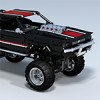
[HELP] Vintage Muscle Car Body for Crawler
VintageCharlie posted a topic in LEGO Technic, Mindstorms, Model Team and Scale Modeling
Hello guys, i'm new to the forum and this is my first post. I suppose this is an unusual thing to post here, but please bear with me.My 4-year old son (big LEGO fan since age of 3, when i started to give him my (by now vintage! :D) childhood LEGO sets) will soon turn 5. He has become good at building and he follows instructions effortlessly, even on a Technic set, which he recently got. I want to make him a very special present and i do not want to just buy yet another LEGO or Technic set - i want it to be one of a kind. Also, at his age an RC car would be a great present and even better if it's LEGO Technic. So the 4x4 crawler would be great, even better would be the 41999 - it's just cooler than the stock model and my son likes it better too. But it would be just another "off the shelf" present. I got inspired by the 41999 set - a different chassis on the 9398 Crawler - and downloaded Lego Digital Designer to experiment around. About me - i'm 30, i have built lots of stuff with LEGO as a child, and now and then i build something together with my son, but i have never owned a Technic set and my only experience with Technic is when i looked how my son assembled a Technic bike set. Also, i have never ever before used LDD. So it's 3 new things for me - eurobricks, Technic and LDD. Anyway, to cut the long story short, i put tons of time into this and i was initially only aiming to see how far i can get on my own in regard to the exterior, the visuals, by doing things that should be possible in real world, but without building the proper structure underneath the exterior. I got surprizingly far, although there are many issues that need to be ironed out on the exterior too (especially the top - i wanted it to be angled, but didn't manage to do it properly. On the other hand, i really like the looks of the model altogether, but i will never be able to design a proper structure that holds the chassis and that holds steering mechanisms, motors, etc. Also, i won't be able to do any design of the mechanics themselves - i've never held a Technic gear in my hand and this structural design is just too advanced for what i can pull off (and i won't have so much time to learn all that stuff til my sons birthday). For someone like me without any experience with this, it is very time consuming to find all the proper parts that might come in handy - that's the biggest handycap as i realised soon - not knowing by heart, what parts could solve a certain problem - that's especially the case with converters, angles, joints and their various types, etc. LEGO has canceled the designed by me service, which might have been another option where to find help. Hence i really hope for your help guys. I was thinking that i could provide the LDD file with the chassis, which i hope can inspire others and, please, feel free to borrow stuff. But i would be really grateful, if someone who is good at building, could come up with the underlying structure that would be needed for this chassis to play nicely with a stock Crawler set. I suppose not all of the exterior design elements will be possible to be implemented the way as it looks now, but i would be glad if the front and back could remain as close to what they look now. If anyone finds the time and interest to help out - you have my gratitude, as i would be stoked, if it would work out and i could give my son such a wonderful and unique present. About the build itself. I think i will call it "69 restomod". I wasn't aiming for a particular muscle car, but i was rather trying to figure out what can be done with the parts that lego offers for this scale, which would be not too big or small for radio control and PF functions. I was mostly inspired by 68 firebird, 68 mustang gt500, 69 dodge challenger - these are elements that hopefully can be recognized in the build. I've attached a couple of pictures and the LDD file in the hope that this might pick up some interest. Any advice or comments would be very welcome. Thank you very much for any help and all the best regards to everyone, Karlis Here are some variations of the most recent iteration of the 69 body design:- 117 replies
-
- power functions
- crawler
-
(and 2 more)
Tagged with:
-

Liebherr LTM 1130-5.1 Scale 1:15
Nick Barrett posted a topic in LEGO Technic, Mindstorms, Model Team and Scale Modeling
A fully motorized and remote control model, sized to suit the old 1980s rubber tyres. 10 Motors, 4 IR receivers, 2 battery boxes. 9kg. Maximum height 2.8 metres Liebherr LTM1130-5.1 in 1:15 Scale by Nick Barrett, on Flickr Functions: Progressive rate steering on 1st, 2nd and 5th axles, powered by L motor. Last axle countersteers. The in-cab steering wheel is connected. Drive by 2 x XL motors on 3rd and 4th axles, and I-6 fake engine. Live axle suspension on all axles Four synchronized stabilisers, powered by L motor with gearbox to switch between extending and lowering. They lock in place when fully down. Slewing of superstructure by L motor. Boom Luffing - XL motor Boom Extension (four sections) by 2 x XL motors Hoist - L motor with gearbox to change speed according to load. Tilting operator's cab, powered by M motor. Liebherr LTM1130-5.1 in 1:15 Scale by Nick Barrett, on Flickr Liebherr LTM1130-5.1 in 1:15 Scale by Nick Barrett, on Flickr Liebherr LTM1130-5.1 in 1:15 Scale by Nick Barrett, on Flickr Displayed at The Great Western Brick Show 2015, before appearing online here. Liebherr LTM1130-5.1 in 1:15 Scale by Nick Barrett, on Flickr


